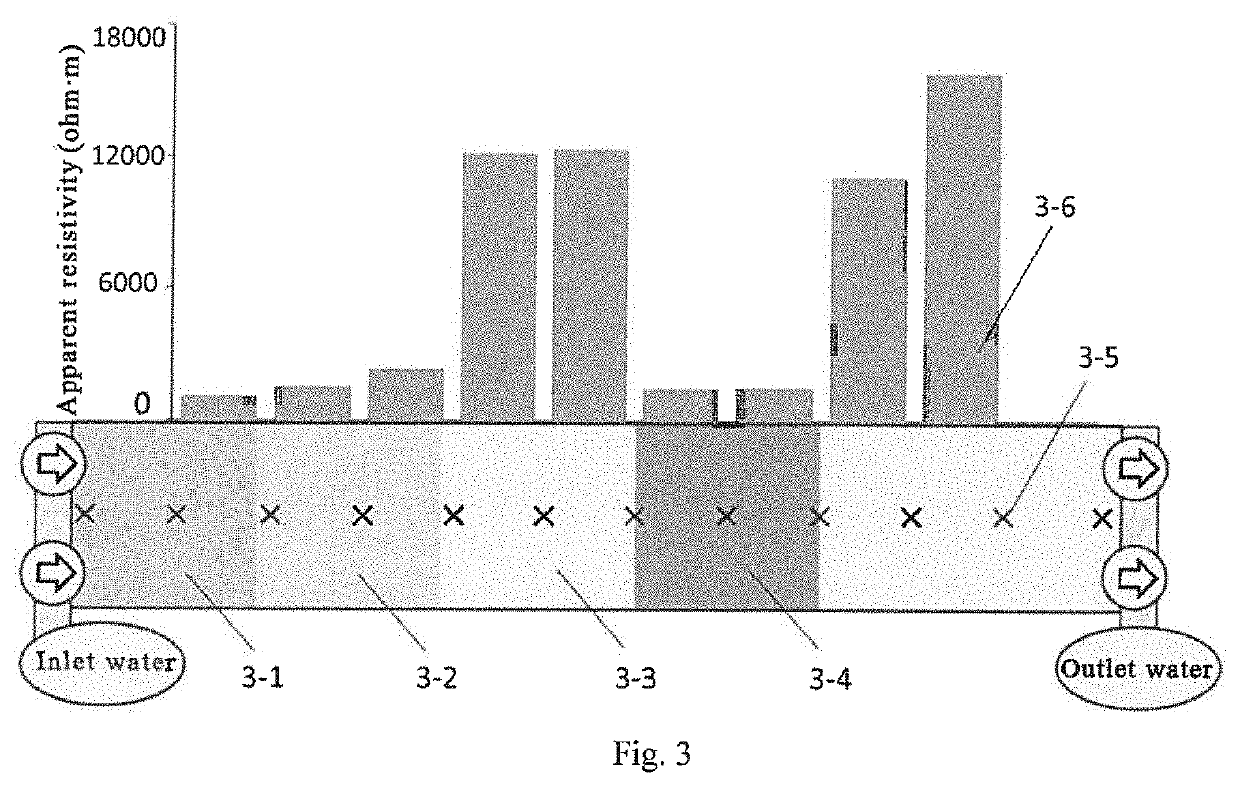Method for detecting clogging of subsurface flow constructed wetland
a subsurface flow and construction technology, applied in the environmental field, can solve the problems of serious hysteresis of the method, affecting the sustainable operation of the system, and consuming a lot of resources, and achieves the effect of strong water holding, reduced apparent resistivity in the region clogged more seriously, and relatively low apparent resistivity
- Summary
- Abstract
- Description
- Claims
- Application Information
AI Technical Summary
Benefits of technology
Problems solved by technology
Method used
Image
Examples
embodiment 1
[0031]The change law of apparent resistivities of fillers of different clogging degrees over time after the water is emptied.
[0032]A subsurface flow constructed wetland model made artificially for different degrees of clogging is adopted for the constructed wetland of this embodiment. As shown in FIG. 1, the apparent resistivity of the fillers with different clogging degrees is measured by adopting a Winner method, the electrodes 1-3 are copper bars having the diameters of 1.5 cm, the lengths of the electrodes 1-3 are 20 cm, the depths of the electrodes 1-3 inserted into the fillers are 15 cm, the distances between the adjacent electrodes 1-3 are all 40 cm, the adjacent two electrodes M and N are measuring electrodes connected to a voltmeter 1-6, the two electrodes A and B on the two sides of the measuring electrodes are power supply electrodes, and the power supply electrodes are connected to an AC power supply 1-4 and an ammeter 1-5.
[0033]The apparent resistivity is measured after...
embodiment 2
[0035]Apparent resistivity distribution of different regions of a subsurface flow wetland clogged.
[0036]A subsurface flow constructed wetland model made artificially for different degrees of clogging is adopted for the constructed wetland of this embodiment. As shown in FIG. 3, the front end of the subsurface flow constructed wetland bed is a clogged region 3-1 having a sediment ratio of 15%, followed by a clogged region 3-2 having a sediment ratio of 10% and an unclogged region and this phenomenon is clogging caused by sedimentation of particulate matters at a water inlet of the subsurface flow wetland. A clogged region 3-4 having a sediment ratio of 25% is in the middle of the unclogged region, and such clogging is regional clogging caused by non-uniform water flow inside the subsurface flow wetland.
[0037]Electrodes 3-5 are iron rods having the diameters of 1.5 cm, the depths of the electrodes 3-5 inserted into fillers are 15 cm, the electrodes 3-5 are arranged along the direction...
PUM
| Property | Measurement | Unit |
|---|---|---|
| depths | aaaaa | aaaaa |
| depths | aaaaa | aaaaa |
| diameters | aaaaa | aaaaa |
Abstract
Description
Claims
Application Information
 Login to View More
Login to View More - R&D
- Intellectual Property
- Life Sciences
- Materials
- Tech Scout
- Unparalleled Data Quality
- Higher Quality Content
- 60% Fewer Hallucinations
Browse by: Latest US Patents, China's latest patents, Technical Efficacy Thesaurus, Application Domain, Technology Topic, Popular Technical Reports.
© 2025 PatSnap. All rights reserved.Legal|Privacy policy|Modern Slavery Act Transparency Statement|Sitemap|About US| Contact US: help@patsnap.com


